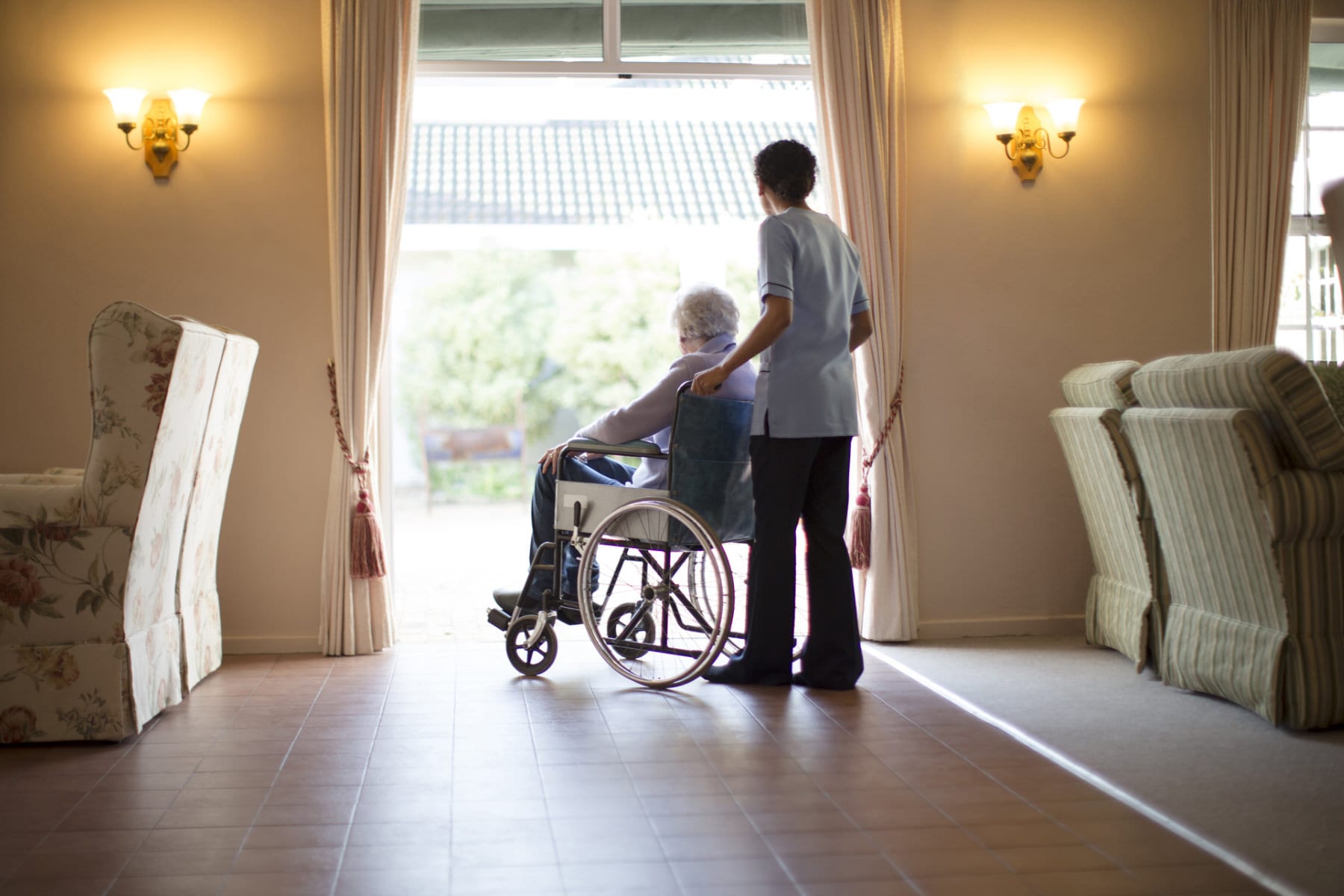For months, Pat Jenkins’s mother was confined to her room. Her meals were brought to her, social events were canceled, and her family was barred from visiting — a situation that the 94-year-old often compared to solitary confinement. Her only physical contact came from a caregiver.
“She has a call button around her neck, by the bed and in the bathroom,” Jenkins said about her mother, Doris Mize, who lives in an assisted living facility in Texas. “She doesn’t toilet by herself, or at least she’s not supposed to, but she still tries if she’s tired of waiting.”
Jenkins said sometimes Mize would push the button repeatedly, but no one would come. She was told there was a shortage of caretakers during the pandemic, as nurses were forced to quarantine or quit from exhaustion. Kept apart from her for more than six months, Jenkins worried about whether her mother was getting what she needed.
Even before the pandemic, long-term care in the United States suffered staffing shortages and high costs, often relying on the unpaid labor of family members. Then, COVID-19 — which has killed more than 184,000 nursing home residents and staff — swept the country, exposing a flawed system and pushing long-term care into what experts have coined its “worst financial crisis in history.”
Now, only a quarter of the country’s 15,600 nursing homes are confident they can keep their doors open for at least one year, according to the latest survey conducted by the American Health Care Association and the National Center for Assisted Living (AHCA/NCAL).
Experts and advocates warn that the crisis is increasingly dire as the country’s population ages. The 65-and-older population — which is expected to more than double by 2050 — is the fastest growing in the country due to aging Baby Boomers and lower birth rates, according to 2019 Census data. And the 85-plus demographic, which is overwhelmingly women, is expected to more than triple by 2050.
And then there is the fallout from the pandemic.
“Even though COVID cases in long-term care are at historic lows, providers are struggling to recover from the economic crisis the pandemic has induced,” Mark Parkinson, the chief executive of AHCA/NCAL, said in a statement.
The cost to fight COVID-19, chronic underfunding of Medicaid and the number of patients dropping to record lows have led to the industry’s near collapse. Nursing homes spent $30 billion on personal protective equipment and staffing in 2020, and the industry is expected to lose a total of $94 billion because of the pandemic, according to the group — which represents more than 14,000 long-term care facilities.
When nursing homes close — and they may as the losses mount — they are required by law to send a written notice to residents and their families at least 30 days ahead of time. The facility is then supposed to give family members agency in decision-making, but residents are sometimes relocated miles and miles away without much say from families, said Marjorie Moore, the executive director of Voyce, an advocacy organization dedicated to older Americans in long-term care and their loved ones. And if that falls through, some families may have to find a way to provide intensive care at home, be it through health aides or having a relative take over full-time caregiving. It’s a cascade of decisions that is likely to have a disproportionate effect on women — who make up the bulk of home care workers and are more likely to take on additional caregiving duties.
Government leaders are aware of the crisis. President Joe Biden’s proposed infrastructure bill would allocate a historic $400 billion investment to expand Medicaid payments to home and community health as part of his infrastructure bill.
But even if more funding becomes available to keep nursing homes afloat, workers and advocates worry that the money may not go where they say it is most needed: keeping staffing levels high enough to provide proper care to residents.
Providers are struggling to recover from the economic crisis the pandemic has induced.
Mark Parkinson, the chief executive of the American Health Care Association and the National Center for Assisted Living (AHCA/NCAL)
The industry at large has been talking about the shortage for years, but Moore said that during the pandemic staff members were expected to work more and more. About 94 percent of nursing homes and 81 percent of assisted living communities are facing a shortage of employees — and the majority of these say the situation has only gotten worse in 2021. One month after the pandemic hit in 2020, more than 1.5 million women lost or left their health care jobs, many citing burnout.
“We support increases in Medicaid, but only if it goes to care staff,” Moore said. She added that she was hesitant to trust that nursing homes — 70 percent of which are for-profit institutions — wouldn’t pocket the increased funding. Many homes are part of larger chains, the networks complex and often opaque, making it nearly impossible to know where money is going. Meanwhile, many of the certified nursing assistants and aides who provide hands-on care receive low pay for labor-intensive work.
A workforce shortage negatively affects residents’ health.
A landmark 2001 study by the Centers for Medicare and Medicaid established that nurses should serve each resident at least 4.1 hours every day to assure quality care. Moore said that she was talking to residents in Missouri that were getting less than two hours per day during the pandemic.
Moore said her staff regularly visits long-term care facilities, gets to know the residents and helps them handle any issues.
“Right now, one staff member was saying that they are just making sure residents are getting three meals a day and getting taken to the bathroom,” Moore said. “These are very basic things that are struggling to be met, which is really scary.”
These are very basic things that are struggling to be met, which is really scary.
Marjorie Moore, the executive director of Voyce, an advocacy organization dedicated to older Americans in long-term care and their loved ones
In May, the U.S. Senate Committee on Health, Education, Labor and Pensions held a hearing to address a shortage in the health care workforce. Despite a robust month of job growth, nursing and residential care facilities lost 9,600 jobs in June, according to the latest data released by the Bureau of Labor Statistics. The country is projected to face a shortage of 54,100 to 139,000 physicians by 2033, according to Dr. David Skorton, the president and chief executive of the Association of American Medical Colleges. In rural areas, Medicaid beds can be difficult to find where there are “fewer formal support programs” and “restricted access to health care,” according to the National Advisory Committee on Rural Health and Human Services.
And the number of doctors whose lived experiences might help in an increasingly diverse nation is far too low, Skorton said. In his testimony, he noted that the percentage of Black men students in American medical schools has largely gone unchanged for the past 40 years.
Several resident advocacy groups released in June a list of critical areas in the long-term care system and called for congressional action to “address the longstanding problems in the long-term care system.” The recommendations included ensuring adequate staffing levels, providing living wages to nurses and increasing ownership transparency and oversight.
“It’s hard for people to understand what folks living in long-term care are going through until you know someone in that situation,” Moore said. “The pandemic really painted the picture.”
In Texas, Jenkins said she was “fortunate” because her mother had worked at a bank for more than three decades, bought extended care insurance and now has the means to pay for a level of caregiving that would cost around $6,000 per month out of pocket. The facility kept residents protected through the pandemic and seems unlikely to close, Jenkins said, but if such a thing happened, “we could not take care of her.”
Recommended for you
From the Collection







